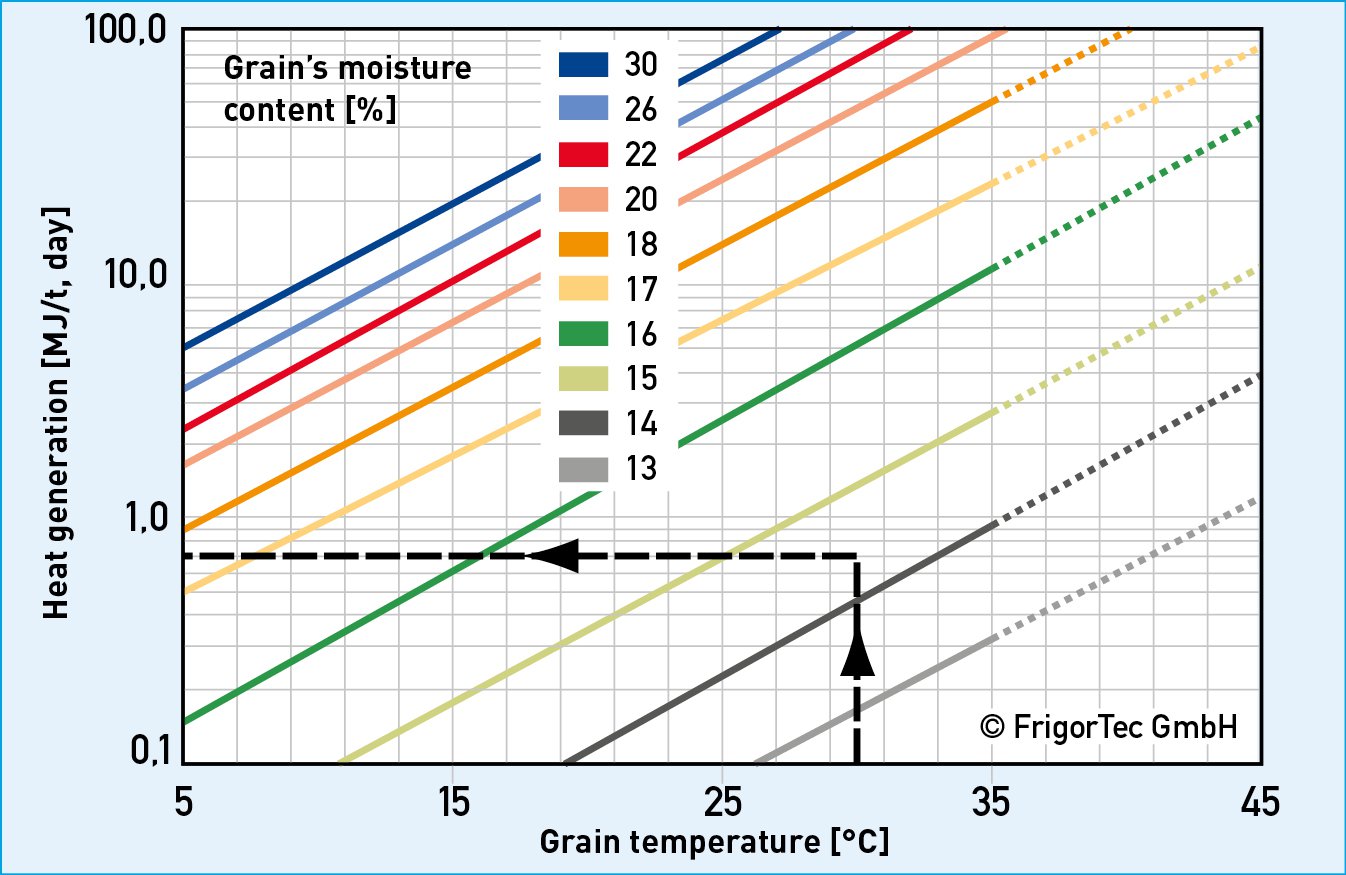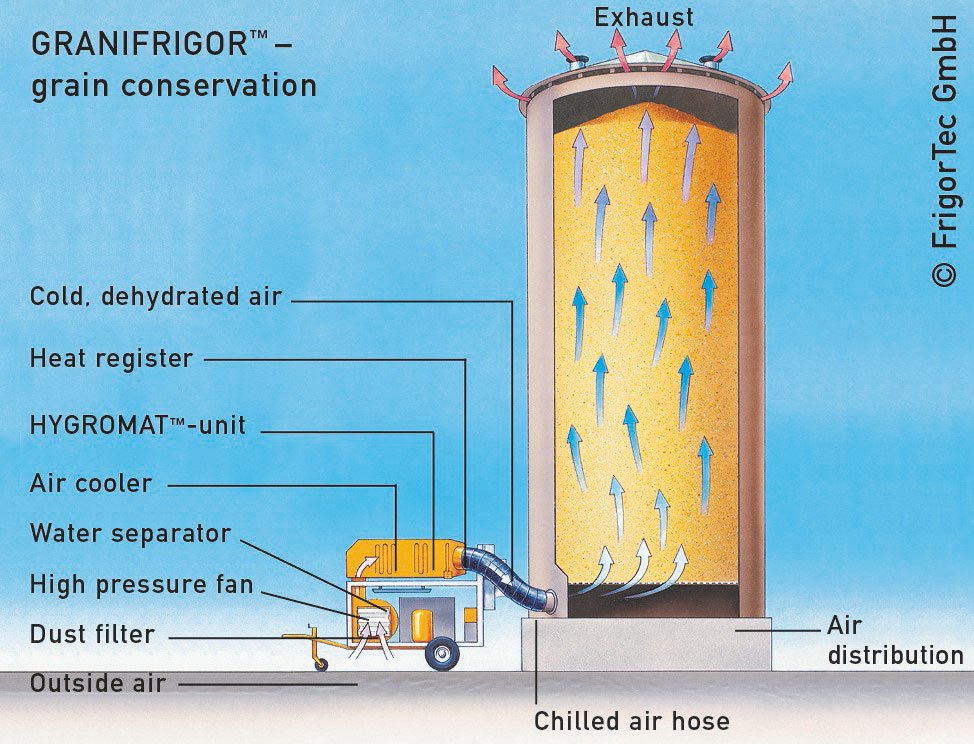How grain coolers work
Grain refrigerators extract from grain and its surrounding air what can be dangerous to it: heat and water. Lowering the temperature and humidity protects the harvest even without chemical treatment.
Protects the grain from the outside and from the inside
After harvesting, the grain should be cooled down to a safe storage temperature as soon as possible. At a temperature of 15 °C or less, insects become dormant and no longer damage the stored grain. The spread of mould and the associated contamination of the grain with toxic mycotoxins can also be counteracted in this way. The cooling also slows down the cellular respiration of the grains. This reduces cellular respiration losses and self-heating (see figure), which otherwise promotes the spread of insects, microbes and mould in the grain.

Cereal grains are hygroscopic: depending on the temperature, there is a balance between the water content of the grain and the humidity of the ambient air. If moist air flows through dry grain, this results in moistening of the grains. It absorbs water and thus spoils.
Ventilation drying works - when the weather is favourable
With simple aeration of grain, the grain is cooled down by an aeration dryer, i.e. a controlled fan. Unconditioned air is used for this purpose and the technique can only be used effectively if the weather conditions are favourable. Only with cool, dry outside air can ventilation drying create stable conditions in the grain. Grain ventilation by itself can even damage the grain under certain conditions but it can still be used effectively in combination with a grain cooler. Immediately after the grain has been harvested, the loose grain is aerated and the grain temperature is reduced to around 22 °C. The grain cooler then cools down to below 15 °C. Modern grain cooling devices condition the ambient air and therefore function regardless of weather conditions. The combination of ventilation and cooling means it is only necessary to purchase of smaller grain cooling device, reducing investment costs.
Cooling conservation with grain cooling units
Grain coolers draw in ambient air and optimally adjust its temperature and humidity to the stored grain. An air cooler extracts humidity from the air and cools the air down. In the next step, the relative air humidity in a post-heating stage is automatically and precisely adapted to the conditions of the bulk grain. The cold, dry air is then pushed through the grain via the air distribution system of the on-floor store or the silo system. It extracts heat and moisture from the grains. Powerful grain coolers are equipped with frequency-controlled fans and have a fully automated controller with individual operating modes. This not only makes operation easier, but also avoids serious errors in the cooling strategy.

The grain's poor thermal conductivity is due to the small contact area and the air-filled cavities between the grains. Chilled over 3-6 weeks, the grain maintains its temperature for 6-8 months due to this intrinsic insulation. Whether rapeseed, malting barley or other grain - advanced coolers enable the conservation of numerous types of agricultural dry bulk. Even in rainy or foggy conditions.
Protection of grain without chemicals
The natural treatment of grain is becoming increasingly important. Organically grown products must not be allowed to come into contact with pesticides even during storage. Malthouses have to ensure that no chemical residues find their way into the beer. Strict official requirements and high costs make methods such as chemical fumigation increasingly unattractive. Cooling preservation with a grain cooler makes it possible to dispense with chemical agents, protecting both the environment and the grain.
Our products
More know-how articles
The best cooling strategy for your grain storage method
Grain can be cold-stored in both floor-level stores and silos. However cooling of the loose grain requires professional air distribution. The grain cooler must also be selected according to requirements. The fully automated control then frees up time for other activities.
How you protect your grain from fungi and pests
The infestation of the grain with pests and the development of secondary fungi must be prevented. It is therefore all the more important to create suboptimal conditions for insect pests and moulds during storage, thereby reducing the risk of spoiling of the grain to a minimum.
Commissioning and maintenance of grain cooling devices
With the new fully automated controller from FrigorTec, the grain cooling unit operates fully automatically. In addition to correct commissioning and settings, careful maintenance is essential for the best possible cooling performance. We describe these and other aspects clearly in our videos.
Combining grain coolers for a flexible solution
Operators of a grain storage facility with a capacity of 76.000 tonnes are looking for a cooling solution that works independently from the weather. A combination of one permanently installed central GRANIFRIGOR™ cooler and two mobile units proves to be a flexible solution that meets all requirements.
Safe storage conditions no matter the weather
A storage facility from the 1970s was designed for ambient ventilation. The switch to a GRANIFRIGOR™ KK 280 AHY allows for precise cooling in all weather conditions. The new cooling solution also eliminates silo condensation problems and prolongs the storage duration of malting barley.
Arrange a consultation appointment
Our experts will be happy to advise you on the planning and implementation of your projects. Together we will find a perfect customised solution.
Arrange an appointment